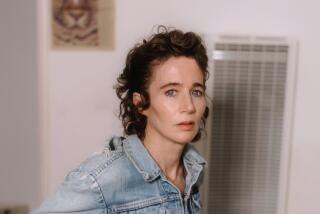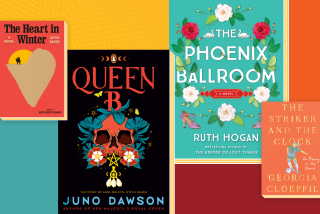Samantha Hunt’s imagination runs wild in ‘The Dark Dark’
“What’s the difference between living and imagining?” asks one of the characters in Samantha Hunt’s first short story collection, “The Dark Dark.” The border between the two states is nebulous in these 10 tales, which slip seamlessly between tart realism and hallucinogenic fantasy.
Hunt perfected this blend in her three novels: The teenage narrator of her debut “The Seas” believes herself to be a mermaid tasked with saving an Iraq war veteran; “The Invention of Everything” injects a storyline about a time machine into a vivid portrait of inventor Nikola Tesla; and most recently, the gothic “Mr. Splitfoot” conjures up two teens left to molder in a foster home who find they can speak to the dead.
“The Dark Dark” specializes in women grappling with the limits of domesticity, trying to regain some sense of who they are and what they have lost. Characters search for signs from the universe and are drawn to the darkness that lurks beyond the safety of their routine existence. Suzanne, a 39-year-old mother of three, is a time bomb ready to detonate in “The Yellow.” She waits until her family is out at the movies “to splatter the house with a combination of things she’d ingested as a teenager — films and punk rock records” in an evening of catharsis. But a chance encounter with a man opens a volatile portal in her life that she may not be able to close.
Women’s bodies are strange and unreliable in these stories, prone to mutation and disappointment. In “Beast,” a woman has nightly dreams that she is turning into a deer. The metamorphosis feels visceral and scary: “hands and feet harden into small hooves, the fingers and toes swallowed up by bone, and then the most frightening part is over with, the part where I lose my opposable thumbs.” She doesn’t want to confide in her husband about her savage dreams; she also doesn’t want to tell him about her animalistic affair with a stranger in a bar bathroom, how the man was “biting my neck and chest like he was lost in some fever, like he was going to eat me with his lips that were thick and filled with blood.”
‘The Dark Dark’ specializes in women grappling with the limits of domesticity.
Lust and fear and hormones course through the book, propelling Hunt’s heroines onward and inward. The drug-dealer-turned-fiction writer of “A Love Story” tries to bring intensity back to her marriage by imagining bad things happening to their young children. “I had great hopes the threat of Lyme disease would revitalize our sex life,” she confesses wryly, but unfortunately, “Lyme disease never really took off in California like it did on the East Coast.” One night, she lies alone in bed after sending her husband out to investigate suspicious noises outside. The longer he is gone, the more furiously she imagines disasters befalling him. She begins to wonder who she will be without him, what will be left of her when the children are grown: “From one small body I made three new humans. It took everything I had to make them.”
The sheer freakiness and magic of reproduction is a running theme. “All Hands” features a female high school administrator dealing with a sudden outbreak of teen pregnancy “sprouting like fungi in our district.” Concerned community members spew irrational blame, attributing the phenomenon to high-fructose corn syrup, poor parenting and feminine hygiene products, among other things. Everyone wants to know who impregnated these girls — everyone but the high school administrator, who believes the girls chose this path as a form of incomprehensible self-expression. “Maybe they are too young to know what they need to say,” she muses. “Or maybe nobody taught them how.”
Women’s bodies are strange and unreliable in these stories, prone to mutation and disappointment.
On the other side of the maternal divide is Norma in “The Story of.” Desperate to get pregnant, Norma haunts online message boards where TTC (for “trying to conceive”) women like herself trade tidbits about procedures and send each other virtual gifts like “baby dust.” (She sends herself some; it doesn’t work.) Although she tries to stay away from such magical thinking, she can’t help wondering whether there’s really a difference between hormones and magic potions. “Neither of them are believable or explainable,” she snipes. Much of what happens in these stories isn’t believable or explainable, and Hunt doesn’t try to resolve or demystify. Her funny, conversational prose and brilliant eye for detail whisk us past any yearning for hard reality.
Hunt fashions intricate narrative structures for her stories; they sometimes end up feeling overstuffed, like an epic novel crammed into a dollhouse-sized book. Some tales leap between multiple points of view; others startle the reader with hairpin twists that force us to reevaluate everything that came before. Nothing is more surprising than “The Story of of,” a haywire sequel to the opening tale in which Norma finds a notebook that offers another, slightly different version of her day, inside of which is still another version of the afternoon, and inside that another — a fictional matrioshka doll in which stories procreate uncontrollably.
It’s a perfect coda to a daring collection in which Hunt gives her imagination free reign, allowing her characters to careen off the rails in their search for something more in the darkness.
Press is the author of the upcoming book “Stealing the Show: How Women Are Revolutionizing Television.”
Samantha Hunt
Farrar, Straus and Giroux: 241 pp., $15 paper
More to Read
Sign up for our Book Club newsletter
Get the latest news, events and more from the Los Angeles Times Book Club, and help us get L.A. reading and talking.
You may occasionally receive promotional content from the Los Angeles Times.







